The Best Sound Cards in 2024
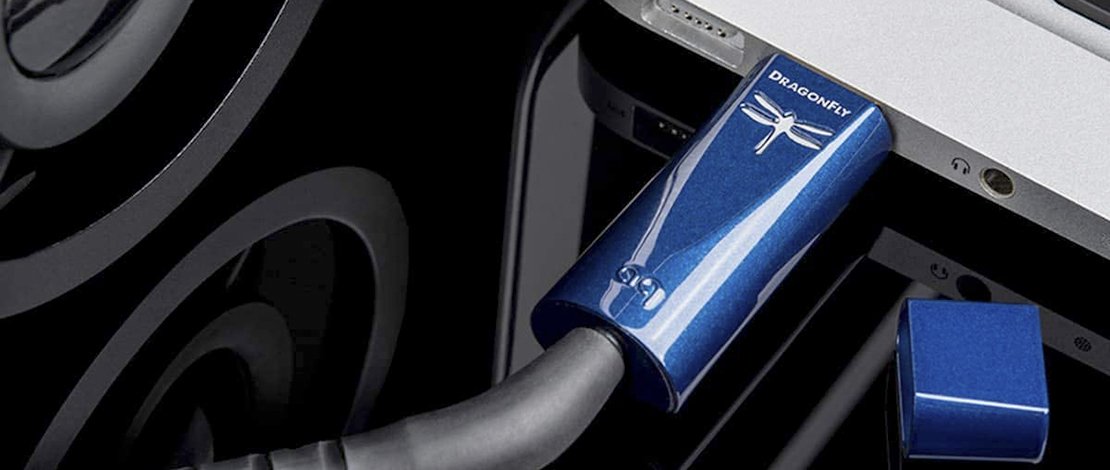
Back in the 90s standalone sound cards were a must in any PC. Motherboards of the time didn’t have integrated sound cards and you had to get one separately if you wanted to listen to music, watch movies, or play games with sound. As years passed motherboards have got much better in handling sound.
Nowadays, most quality motherboards, especially high-end gaming motherboards, come with excellent sound cards. For most users, these are more than enough. But if you want the best sound card available, you have to look for standalone models.
These come with control modules to adjust sound levels for each device you’re using, with additional ports to attach various audio devices, with a plethora of options for those who want to delve into sound recording, and with perfectly clear sound deserving of audiophile headphones and speaker systems.
We scoured the internet and found nine sound cards that should satisfy even the biggest audiophiles. We have high-end choices, excellent budget options, USB cards for those who seek for external options, and a couple of excellent DACs. Check them out below.
Best Sound Cards
Creative Sound Blaster Z SE
Solid Medium-Range Sound Card
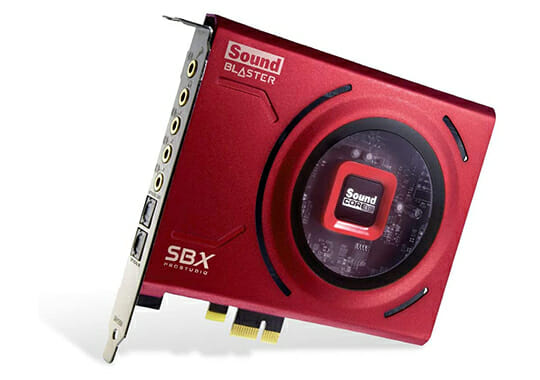
- Up to 192kHz/24-bit
- Up to 600-ohm headphones
- 116dB signal-to-noise ratio
- Sound Blaster Command software
The Creative Sound Blaster Z SE is an internal PCI-e gaming sound card that aims to improve your audio quality and allows you to plug in higher impedance headphones that need more power to work properly.
This Creative sound card can output audio at up to 116 dB SNR at a 24-bit / 192 kHz bitrate for high-fidelity audio listening. It can also be used as an amplifier for studio-grade headphones and can give enough power for headphones that have an impedance of up to 600ohm.
Another big reason why the Sound Blaster Z SE is impressive is that it also supports virtualization technology allowing you to fully use your 7.1 surround sound headphones. To customize all of your settings this device comes with the Sound Blaster Command software which will allow you to set up your basic audio settings and also tinker with EQ, audio profiles, crystalizer effects, etc.
- A decent sound card that will allow you to increase your audio fidelity
- Can power studio-grade 600-ohm headphones
- Can be used for virtual surround sound headphones
- Has competent software that allows you to customize your sound even further
- A little bit outdated in terms of specs and will not allow for someone hunting for audiophile-grade sound to fully enjoy their experience
Asus Xonar SE
Entry-Level Budget Sound Card
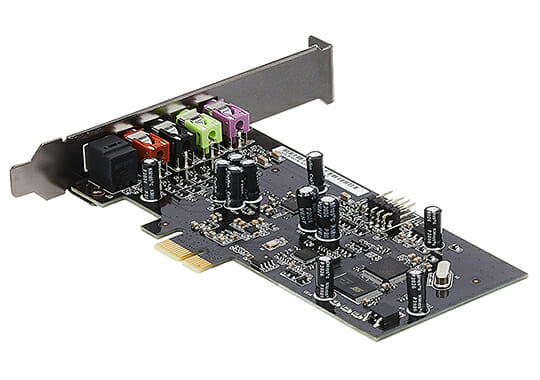
- Up to 192kHz/24-bit
- Up to 300-ohm headphones
- 116dB signal-to-noise ratio
- Xonar Audio Center
If you are just getting into audio hardware or simply have a really bad audio device on your motherboard and want something a little bit better you should look into entry-level sound cards like the Asus Xonar SE.
This is a 40$ investment in 192kHz/24-bit, 5.1-channel playback that will also allow you to power higher ohm headphones for better audio quality. Even though this is not exactly the highest quality of audio, for normal gaming purposes and general use this soundcard is perfectly fine.
The sound card comes with grounding technology that also allows minimizing distortion and audio crossover interference. Overall this tiny little sound card will output with a high 116dB signal-to-noise ratio for an improved audio experience.
For extra tweaking power, you are also encouraged to use the Xonar Audio Center software which will allow you to implement features such as EQ and audio profiles natively.
- Very cheap audio hardware for entry-level enthusiasts
- Can power higher impedance headphones for better volume and clarity
- Comes with software
- Is not exactly made for audiophile listening and is not that much better than a high-quality modern motherboard audio codec.
Creative Sound Blaster AE-7
The Best Sound Card For Gaming
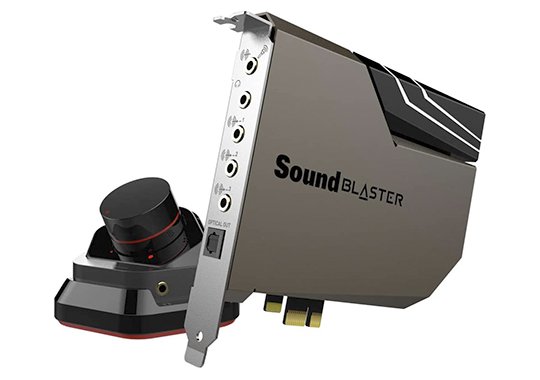
- Interface: PCIe x1
- Signal-To-Noise: 127 dB
- Output Configuration: 2 Channel, 5.1 Channel, 7.1 Channel (Virtual Surround)
- Playback Format/Recording Format: Up To 384 kHz@32bit / Up To 96.0 kHz@32bit
If you want the best sound for your games, get the Creative Sound Blaster AE-7. This is a card made for the top of the line gaming experience. It features extensive support for a variety of headphones, supporting 7.1 virtual surround that can sound pretty good. The software suite is pretty good. Modern looking, filled with features, and easier to use than most suites offered by other manufacturers.
Next, the card comes with an audio control unit allowing gamers and streamers to control their audio devices without any hassle and to quickly swap connected devices. The card can heighten your experience of listening to music in case you have a quality speaker setup or solid headphones but the quality isn’t as high as with ASUS Essence STX II or NZXT Nu Audio.
- Great Gaming Performance
- Solid Music Performance
- Audio Control Module Included With The Card
- Pricey
- Not Suitable For Audiophile Equipment
EVGA NU Audio Pro 7.1
Excellent High-Quality Sound Card
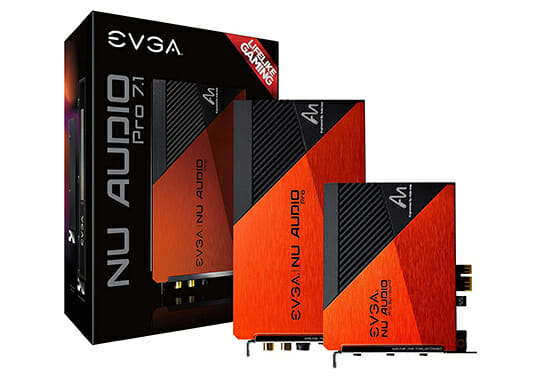
- Up to 384kHz at 32-bit
- Up to 600-ohm headphones
- 123dB signal-to-noise ratio
- 7.1, 5.1, 4.0, and 2 channel outputs
Sound cards are not exactly popular anymore with more people preferring external Amp+DAC combos to enhance their listening experience. At the same time, if you want to forego the extra device on your table and want to tuck it into your PC while maintaining a high-quality level of audio then the EVGA NU Audio Pro 7.1 is an excellent choice for you to review.
The Pro in the name of this EVGA sound car is not just for show because this device has a dynamic range of 123dB and uses an XMOS xCORE-200 for audio DSP. It can be used to playback files up to 384kHz at 32-bit which is the highest level of audio files currently available.
The EVGA NU can power headphones up to 600ohm which means you basically can use any studio headphones with no worries about them not having enough juice to run properly. The 7.1 in the name of the device is also not just for show as the NU Audio Pro supports 7.1, 5.1, 4.0, and 2 channel outputs for your sound.
At the same time, you must also know that buying this device without having proper headphones will barely increase the audio quality and you are better off just using the integrated audio from your motherboard. Your decision will vary depending on your current situation, but overall this is an excellent audio device.
- High-quality device
- Can play audio files at a crazy 384kHz at 32-bit
- Can power most studio headphones with a 600 ohm impedance
- Contends with all other high-end sound cards/Amp&DACs
- The fact that this is an internal sound card means that cross-talk and other signal interference is present which is an issue external sound cards do not have
- Is only a worthwhile investment if you have other high-end hardware like studio headphones or speakers so you can hear the difference in sound quality
Creative Sound Blaster Audigy FX PCIe 5.1 Sound Card
The Best Budget Sound Card
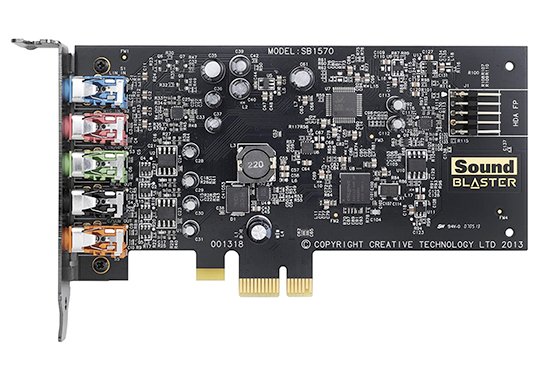
- Interface: PCIe x1
- Signal-To-Noise: 106 dB
- Output Configuration: 2 Channel, 5.1 Channel
- Playback Format/Recording Format: Up To 24-bit, 96 kHz
If the integrated sound card on your motherboard died or if you need a solid budget standalone sound card because the one on your motherboard is awful, check out this one. It offers great audio quality for the price, just don’t expect miracles.
It will work great with mid-range speakers and headphones, but don’t bother to pair it with high-end audiophile equipment. Also, it’s great for surround experience since it natively supports 5.1 speaker systems. Finally, Creative offers great software that comes with this card, offering plenty of features allowing you to tweak your audio settings in detail.
- Solid Performance For The Price
- Affordable
- Not For Audiophiles
- Made As A Basic Replacement For Integrated Sound Cards
AudioQuest Dragonfly Cobalt
Premium USB DAC With Impressive Performance
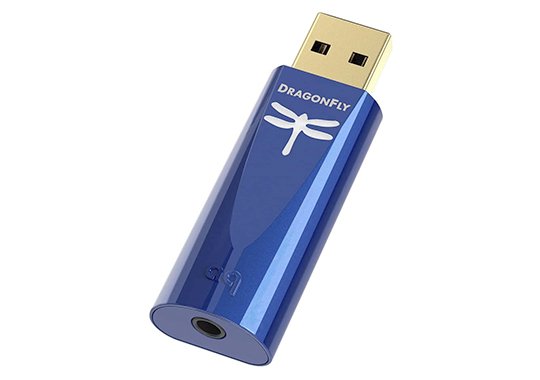
- Output voltage: 2.1V
- Headphone Amp: ESS Sabre 9601
- DAC Chip: ESS ES9038Q2M
- Dimensions: 12mm H x 19mm W by 57mm L
Dragonfly Cobalt from AudioQuest is a premium digital-to-analog converter and headphone amplifier that’s perfect for those who want the best audio quality on the go. It can be paired with smartphones and laptops in just a few seconds and once attached, it will turn your phone or laptop in a top audiophile device. If you need only a quality DAC for your laptop without additional features, this one can replace even the best external sound cards for laptop out there.
This DAC has superb performance. Wide soundstage, crisp sound with almost zero noise, incredible dynamic range, and near-perfect timing. This DAC works perfectly with any pair of audiophile headphones and it comes with a nice USB A to USB C adaptor to use it with Android phones featuring USB C ports. If you own an iPhone or an older Android phone, you’ll need a separate adaptor.
- Superb Audio Quality
- Crystal Clear Sound
- Wide Soundstage
- Excellent Dynamic Range
- Ultra Portable
- Pricey
Creative Sound BlasterX G6
The Best External Sound Card
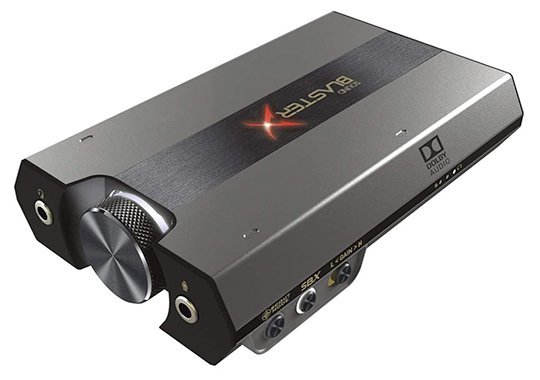
- Signal To Noise: 130 dB
- Output Configuration: 2 Channel, 5.1 and 7.1 Channel (Virtual)
- Playback Format/Recording Format: Up To 384 kHz and 32bit
- I/O: Optical In, Optical Out, Micro USB, Headphone Jack, Microphone Jack
The Sound BlasterX G6 is the best external sound card for gamers, period. It can work with PC, Xbox One, PlayStation 4, and Nintendo Switch. It will probably also be compatible with the Xbox Series X and PlayStation 5 when these two next-gen consoles come out. The card itself is on the chunky side but that’s cool because it comes with a variety of features.
The card’s setup process is extremely straightforward. There’s no calibration required, just connect the card with an audio port and a USB port and you’re set. Once you start gaming, you’ll notice a perfect sound quality.
Clear sound with excellent channel separation, boosted ambient noises that improve the overall experience in any game, expansive dynamic range, and SBX mode that provides excellent virtual surround along with widening the soundstage. Overall, this is an excellent gaming sound card with the price and limited input selection being its only major drawbacks.
- Superb Gaming Performance
- Works With Any Console And PC
- Simple To Use
- Pricey
- Limited Input Selection
FiiO K5 Pro
An Easy Choice
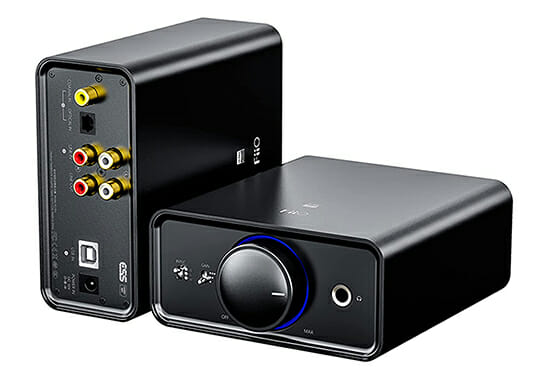
- ES9038PRO with 32-bit processing
- XUF208 USB decoding chip
- Coaxial/optical/RCA
- External DC 15V power supply
At this point there is probably not a single person that has looked into the AMP/DAC market and has not heard about the FiiO K5 Pro, making it an easy choice for anybody that wants to elevate their audio experience.
The K5 Pro comes with an ES9038PRO with 32-bit processing and the XUF208 USB decoding chip with 768kHz and DSD256 inputs. You also get a bunch of connections like coaxial/optical/RCA line-in inputs which means you can use this device with consoles as well.
The K5 Pro can easily handle low or high-impedance headphones (people have used 300Ω – 600Ω without issues) making it a very good primary recommendation for anyone that wants a solid experience without having to rely on their puny motherboard built-in sound card.
There is not much more to say about the K5 Pro besides it being a staple on the entry market for audio enthusiasts, and there is a reason why it keeps holding onto that position to this day.
- Solid metal box with a decent feeling knob for volume control
- The K5 Pro can handle most headphones in the entry-mid level audiophile category
- The reason this device is so popular is because it can use both coaxial/digital inputs
- The volume control on the knob is separate from Windows volume control
- The K5 is pretty decently sized so it is not exactly a portable device with that external power brick in tow
Creative Sound Blaster X4
A Solid Mid-Range Experience
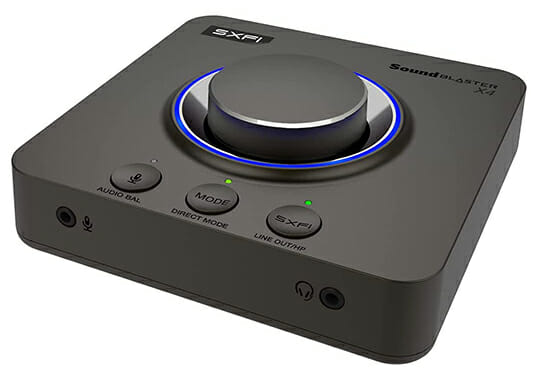
- Up to 192kHz/24-bit
- Up to 600-ohm headphones
- 114dB signal-to-noise ratio
- Sound Blaster Command software
The Creative Sound Blaster X4 is an external sound card otherwise known as an Amp/DAC. This device serves the same purpose as an internal sound card – to elevate the quality of the sound reproduction.
In that regard, this is a solid choice since the X4 can perform at 114 dB signal-to-noise ratio and playback files at 24-bit / 192 kHz. As with most other devices on this list, it has a good AMP inside of it therefore can power studio headphones with up to 600 ohms of impedance.
With the Creative Sound Blaster X4, you can also plug in your microphone for more control over your volume and quality allowing you to achieve better communication in your games, a great bonus for gaming.
The X4 also boasts 7.1 surround sound virtualization with Super X-Fi technology and Dolby Digital Live which is nice for a more immersive experience during your gaming hours. The main selling point of this device though is the software customizability with different sound profiles and audio adjustments through the Sound Blaster Command App.
If you want a pure audiophile experience then this device definitely is not for you, but if you are a gamer that wants better audio then this is an excellent choice.
- A great choice for gamers
- Can power up most gaming and studio headphones with no problems
- Can plug in your headset microphone for more gain and volume control
- Has great software with a lot of sound profiles and audio customizability
- This is definitely a gaming-oriented device and not exactly an audiophile one with its focus on the overall experience and not sound quality
How To Choose A Sound Card
Picking the right sound card doesn’t have to be a hassle. While there are plenty of models out there, there are a few features you should focus on. Stuff like the signal to noise ratio, sampling rate, how many sound channels different sound cards support, connection type, whether a card is internal or external. Let’s talk about these points, one by one.
What Is Signal To Noise Ratio And Why It Is Important
Signal to noise ratio (SNR) tells about the clarity of the sound coming from the sound card. It’s basically the difference between the signal power and noise power and the higher it is the clearer the sound.
This ratio is expressed in decibels. For instance, is a signal to noise ratio is 50 dB that means that the audio signal coming from the card is fifty decibels higher than the noise signal. That’s pretty bad SNR value. With SNR being 50 dB, you will clearly hear the noise at higher volume levels. In other words, the sound won’t be clear.
You should look for sound cards with at least 100 dB SNR. That’s the lower limit you should agree to when picking a sound card. And don’t forget that signal to noise ratio isn’t the only important feature to consider.
What Are Sampling Rate and Bit Rate
The sampling rate reflects how accurately a sound card can reproduce higher frequencies. You can calculate the upper limit of the accurate reproduction of a sound card by dividing its sampling rate by two.
For instance, a 96 kHz sound card can accurately reproduce frequencies up to 48 kHz. And that’s more than enough because the upper limit of human hearing is 20 kHz. So, when looking for a sound card, a sampling rate of 96 kHz (the usual rate of mid-range cards) is more than enough.
Bit rate plays a role in the quality of recorded sound. Professional recordings usually use a 24bit rate, which is more than enough when it comes to sound quality. Look for sound cards with 24bit rate or higher.
5.1 Vs. 7.1 Sound Cards
The numbers tell the whole picture. 5.1 cards support six audio channels while 7.1 cards support eight audio channels in total. 7.1 surround sound is a bit better if you have the right speaker system, but that shouldn’t guide you when looking for a sound card.
You should just look for a card that supports your speaker configuration. If you are using 5.1 surround speakers, 2.1 system, or headphones, you shouldn’t worry about getting a 7.1 sound card.
When it comes to 7.1 headsets, they will work with any sound card if they are USB-based. USB headsets have their own sound card inside them and will have eight channels no matter which sound card you’re using.
And yes, you can use 7.1 headsets with 5.1 sound cards. They will just play six channels instead of eight. Just remember that most 5.1 and 7.1 headsets offer virtual surround. They use two drivers but create virtual surround sound via software. Real 7.1 headphones often come with their own sound cards that support the true 7.1 setup.
USB Vs. PCIe Sound Cards
USB sound cards are external cards that hook to your PC via USB port. They can be placed anywhere within the limit of the cable and some have microphones allowing users to record audio directly with the sound card.
PCI and PCIe sound cards are internal cards that have to be mounted inside your PC case. They use PCI or PCIe ports on the motherboard with most modern sound cards opting for PCIe interface because PCI ports are all but dead on modern motherboards. They offer lower latency than USB cards, at least on paper, and offer better sound quality since they can use more power from the PCIe port.
Gaming Vs. Audiophile Sound Cards
Another major difference between sound cards is their main purpose. You have models designed to offer the best gaming experience and then you have audiophile sound cards. If you want the best gaming experience but still want an excellent (but not stellar) listening experience, get a high-end gaming sound card. These often have excellent music performance.
If you have serious audio equipment and want the best listening experience go with an audiophile sound card. Those are designed to offer the best possible listening performance and to work with headphones and speakers that cost thousands of dollars.
Do note that some external sound cards made for gaming support consoles as well as PC. If you’re a versatile gamer who likes consoles and PC check whether the external sound card you’re after offers console support.
Maybe It’s Better To Invest In A Pair Of Quality Headphones Than Getting A Standalone Soundcard
Finally, if you have a quality motherboard there are good chances it comes with more than a decent integrated sound card. Instead of investing money in a standalone sound card, you should get a pair of quality headphones or a nice speaker system since your integrated sound card should be more than enough for the majority of headphones and speakers available on the market.
Budget headset would work fine with almost any sound card, but if you want a high-end headset, it’s better to get a nice headphone amp and DACadset for those headphones than to invest in a sound card. A standalone sound card should only be considered if you want the ultimate experience with Hi-Fi speakers, if you need an external sound card for gaming, or if you’re into recording.
STX II i have owned, twice. Excellent sound quality, good components, official drivers are decent, unofficial unixonar even better. Now something that is not great is the mic, its actually very bad, i would rate it worse than the cheapest onboard mic input’s i tried. The volume is to low, no way around it other than to boost the hell out of it, the result is decent volume, but horrible quality, no way around it. The EVGA Nu series i wouldnt order before taking a real good look at the number of issues with this thing. Just take one look… Read more »
Kkkkkkkkkkkk Sond Blaster AE-5 Plus, AE-7 and AE-9. Hater is awesome! I have an AE-7 and I listen to music with very high audiophile quality. In addition to games and movies with impressive audio quality. Creative has always been the leader in the segment. I feel inside the show, the movie and the games. With precise and crystal clear audio quality. In addition to being very immersive.
It’s very sad to me that manufacturers have opted to make sound cards for gaming and let audiophile-oriented cards slip down the priority list. Guess gaming is where the money is, but I hope manufacturers read threads like this and (re)develop top-shelf cards for audiophiles alongside gaming cards. ASUS no longer makes the Essence STX II. They only offer the Xonar AE and Xonar SE now, and neither has super-impressive spec’s on paper, although the AE looks to be better overall even though it’s marketed as their “gaming” card. Their tech people couldn’t answer anything beyond reading from their own… Read more »
I had Asus Essence One MKII MUSES Edition, my AE9 with Sparkos Opamps ate it any time. So the Creative thought about audiophiles. Don’t believe to a news writer who doesn’t know the AE9.
Goran,
Old, long since given it up, audiophile here.
Thank you for the great article. I really appreciate you explains S/N ratio and your summary at the end.
Great advice in a very noisy internet.
Bullshit! You showed the full Evga palette, but you didn’t show the full Soundblaster AE palette. The SB AE9 is missing. I think mine can kill all of your soundcards here. 😉